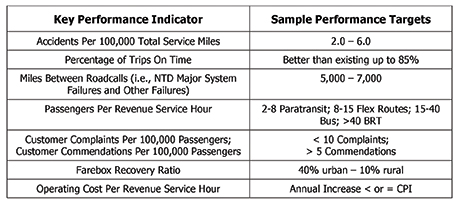
Setting performance targets
for key indicators
By Mary Sue O’Melia
You have decided on key performance indicators (KPI), identified data sources and started collecting data. You can now monitor if you are getting better or worse relative to prior periods. But how do you know if you are good and getting better or are just awful despite improvements?
Key performance indicators (KPI)
A suggested list of key performance indicators was provided in the November 2014 issue of BUSRide Magazine, as shown below. Definitions and the reliability of alternative data sources have been discussed in this column since that time. At this point in time, agencies should be able to calculate most of these indicators using their FY 2014 NTD Report. Preliminary figures for the first quarter of FY 2015 should also be available.
 What is good performance?
What is good performance?
Targets should represent improvements the agency desires to achieve. Service plans and annual budgets provide much of this information, as does past performance. Sadly, if implemented as planned, some service plans and budgets result in declining performance. The focus should be on the status of the agency after three or five years of continuous improvement. Below is a sample of some performance targets that represent reasonable levels of overall performance.
 Peer reviews to put performance in perspective
Peer reviews to put performance in perspective
Requirements that transit agencies meet specific performance criteria vary from state to state and may differ based on the type of service and area of operations (urban versus rural).
A number of agencies conduct peer reviews using data available from the NTD website www.ntdprogram.gov. This helps with understanding your own agency’s performance relative to others of a similar size and operating environment.
The American Bus Benchmarking Group (ABBG) is another forum for determining performance relative to peers. While the forum is limited to mid-size transit operators, those that participate are able to determine agencies with the best performance or those agencies able to make the most improvement. How did my peers achieve these results? What programs did they implement and would these same actions work in my environment?
Take measurable actions to improve performance
The purpose of setting targets and monitoring performance is to help the team improve performance. This requires that the team be involved in identifying performance targets and the development of actions to improve performance.
For example, the Scheduling Team may decide to work on the 10 routes with the lowest on-time performance. Or, select the top five routes based on ridership and work on improving schedule adherence to provide the biggest benefit to the most riders.
All transit agencies are interested in improving safety. What is the most frequent type of accident at your agency? Passenger slip and falls due to sudden stops? Or falls when the bus leaves the stop? Analyzing causes and conditions can point the way to actions. Actions can be measured in terms of effectiveness. Did we accomplish what we set out to do?
Conclusion
Information and technology are tools that have value only if an agency uses them to improve safety and performance or to provide an outstanding travel experience for customers. What is your agency doing with the data and technology in which you have invested?
Mary Sue O’Melia is president of TransTrack Systems®, Inc., a business intelligence solution that transforms volumes of data into meaningful information for transportation managers and executives to use in planning, strategizing and ensuring optimal performance. Visit TransTrack Systems® at: www.transtrack.net
